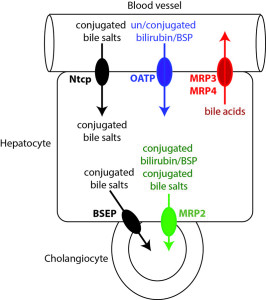The main transporter for bile salts is the Nctp, sodium-dependent transporter on the sinusoidal membrane, the energy for which is obtained from a sodium/potassium pump on the sinusoidal membrane (not shown). Bile salts are mostly exported into bile by the bile salt exporter protein (BSEP), which creates the dominant force behind bile salt-dependent bile flow. Conjugated bilirubin and bromosulphalein (a dye used to measure hepatic function), and perhaps unconjugated bilirubin, are taken up from blood by the OATP transporter family at the sinusoidal membrane and then excreted (with some conjugated bile salts) into bile via the MRP2 transporter. Changes in these transporters and energy provides (sodium/potassium exchanger) occur with bile duct obstruction (upregulation of MRP3, which reverses the flow of bile acids back into blood) and secondary to lipopolysaccharide or inflammatory cytokines (“functional” cholestasis). Not shown are exchangers of other organic compounds or those that contribute to bile salt-independent flow (bicarbonate/chloride exchanger).

